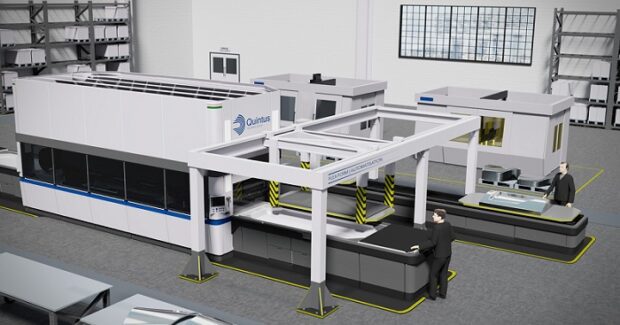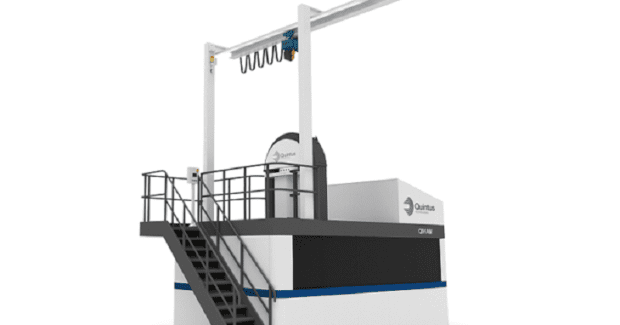Removing Barriers in High Pressure Fabrication
High Pressure Warm Forming technology and Hot Isostatic Press systems from Quintus emerge as cost effective approaches to forming Ti-6Al-4V titanium and streamlined post processing for leaner AM operations.
Posted: September 11, 2019
In Booth D-46071, high pressure expert Quintus® Technologies LLC (Lewis Center, OH) will showcase their latest advances in sheet metal forming: High Pressure Warm Forming (HPWF) and the Flexcell™ system. HPWF is a breakthrough process that combines high pressure with a moderately-elevated temperature for more rapid, cost effective and precise forming of titanium parts. It paves the way for more widespread adoption of Ti-6Al-4V, the grade of titanium prized in aerospace, medical, marine and other sectors for its high strength, light weight, formability and high corrosion resistance. HPWF removes barriers to fabrication that previously limited the use of Ti-6Al-4V to specialty applications due to the high cost of current forming methods.
Conventional milling has a scrap rate that can approach 70 percent. Hot forming processes, which take place at temperatures of above 1,300 deg F (700 deg C), require an oxygen-free process atmosphere and entail several lengthy steps. HPWF significantly improves on these methods by introducing an induction heating system to warm the blank-and-tool package to approximately 520 deg F (270 deg C) – well below the temperatures where a protective gas is required – just before entering the Flexform™ press that applies uniform high pressure (20,000 psi/140 MPa) to a flexible rubber diaphragm in conjunction with just a single rigid tool half to form complex sheet metal parts to final shape. A complete HPWF cycle, from heating and loading to forming and unloading, takes less than five minutes. Forming at relatively low temperatures enables quick cooling. Overall, the efficiencies generated by this process dramatically boost the production capacity for Ti-6Al-4V parts, increasing throughput by a factor of five over traditional hot forming processes.
Flexcell is a production system dedicated to efficient, low-volume sheet metal fabrication that is based on Flexform technology. It uses a single rigid, shape-defining tool half, in conjunction with a flexible rubber diaphragm under high hydraulic pressure, to form complex-shaped sheet metal parts to close tolerances with little or no manual rework. Flexcell minimizes the time for tool changes and new tool set-up, substantially increasing productivity while allowing fabrication of small production batches when a wide a variety of part shapes is required. Ideal for dynamic industry sectors that demand ever-shorter lead times, this system enables rapid trials and tool modifications after component design changes. It represents the next generation of Flexform production technology incorporated in the QFC 1.2×3-1000 fluid cell press that generates a pressure level of 14,500 psi over a forming area of 47.2 in x 118.1 in (1,200 mm x 3,000 mm).
Also on display will be a new model Hot Isostatic Press (HIP) that removes production bottlenecks in additive manufacturing (AM) by consolidating stress-relieving, heat-treating, and parts aging in a single cycle. Equipped with proprietary Uniform Rapid Cooling™, the QIH 60 M URC® press combines heat treatment and cooling in a single process known as High Pressure Heat Treatment (HPHT). This innovative approach reduces the number of production steps, resulting in faster throughput and higher work piece quality, along with lower capital investment, improved logistics, and energy savings. The QIH 60 is a revolutionary piece of equipment that will enable mass production of parts with exceptional quality and reduced cost. Hot Isostatic Pressing has become the standard method to eliminate pores and remove internal defects in metal and ceramic parts, improving properties such as toughness and fatigue life. With the ability to stress-relieve, heat treat, and age parts in one system, HPHT allows manufacturers to consolidate several steps and remove discrete equipment from the production line. It is rapidly emerging as the go-to post-processing path to lean AM operations.
Equipped with digital controls for precise heating and cooling performance, this new press has been designed to integrate with Industry 4.0 and factory-of-the-future connectivity. The QIH 60 operates at a maximum temperature of 1,400 deg C (2,552 deg F) and pressure of 30,000 psi (2,070 bar) when using the molybdenum furnace. Graphite furnace options are also available for temperatures up to 2,000 deg C (3,632 deg F). The working dimensions of the vessel are 410 mm (16.14 in) diameter and 1,000 mm (39.37 in) tall, with a capacity of 600 kg (1,322 lb) per load, allowing loading of full build plates from the majority of printers. Its proprietary wire-winding technology is widely recognized as the most reliable and durable pressure containment system ever designed. Completely documented quality systems govern all phases of the production process and comply fully with ASME U3 and CE (PED) quality standards.
Active controlled cooling facilitates stress relief, hot isostatic pressing, quenching and aging in the same HIP system with significantly higher productivity. This capability makes the QIH 60 M URC especially well-suited for materials that require rapid cooling or quenching after annealing, decreasing lead times and often eliminating the need for outsourced treatments. A rigorous Quintus Care agreement secures operational excellence and provides access to their vast HIP application knowledge. “HPHT introduces multiple efficiencies and dramatically lowers per-unit processing costs,” noted Jan Söderström, the chief executive officer of Quintus Technologies. “We are very pleased with the role this new, state-of-the-art HIP can play in moving additive manufacturing forward into robust, lean production.”
Quintus Technologies LLC, 8270 Green Meadows Drive N, Lewis Center, OH 43035, 614-891-2732, Fax: 614-891-4568, [email protected], www.quintustechnologies.com.
















